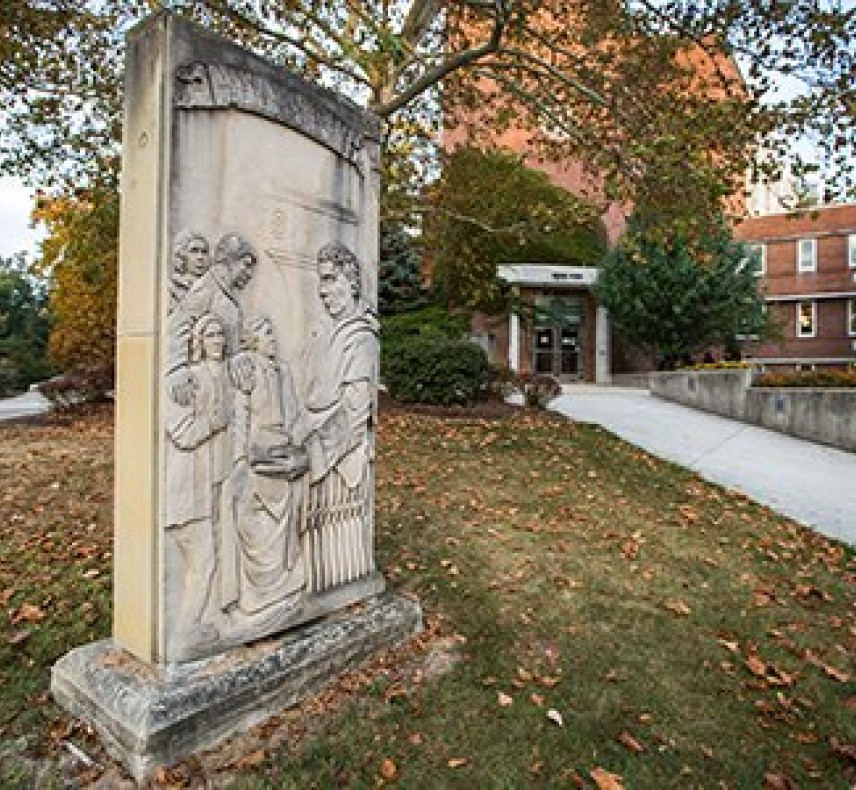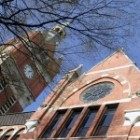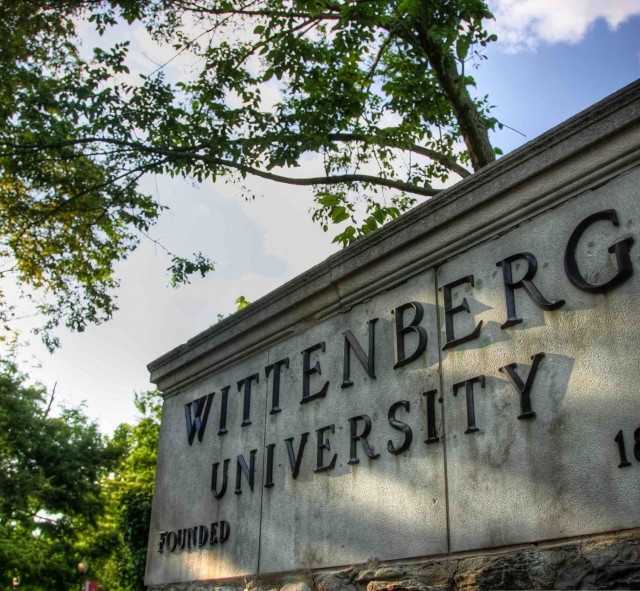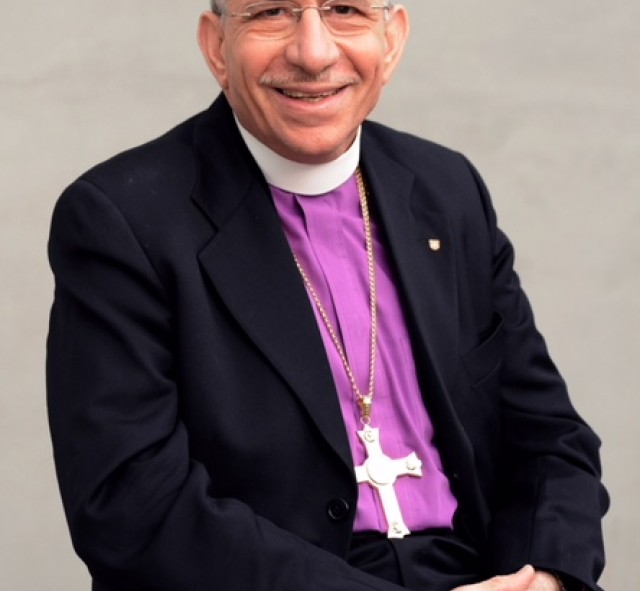Reformation resources and artifacts are currently on display in the Thomas Library at Wittenberg University until Jan. 8.
Some of the items include a first edition of The Book of Concord, a 1520 copy of Martin Luther’s Prelude on the Babylonian Captivity and an autographed letter from Luther.
In addition, Thomas Library is host to a poster exhibition, which richly portrays the people, events, and ideas of the Reformation, with special focus on Luther. These 30 posters were provided from an online resource by the German government and replicate the posters used in the 2016 Reformation exhibitions in Minneapolis, Minn., New York City, and Atlanta, Ga.
This display is an opportunity for church and school groups, from confirmation to Bible studies and adult education groups, to see these historical artifacts up close and in person.
To set up a group visit, which can also include a tour of Weaver Chapel and/or of campus, contact Dan Jacob, ELCA and Campus Ministry Associate at Wittenberg, at jacobd@wittenberg.edu or 937-327-7494.
 Individuals can drop by any time Thomas Library is open. Hours are Monday through Thursday from 8 a.m. to midnight, Friday from 8 a.m. to 9 p.m., Saturday from 10 a.m. to 9 p.m. and Sunday from noon to midnight. If you plan to visit during Wittenberg’s winter break, be sure to check our website for library hours.
Individuals can drop by any time Thomas Library is open. Hours are Monday through Thursday from 8 a.m. to midnight, Friday from 8 a.m. to 9 p.m., Saturday from 10 a.m. to 9 p.m. and Sunday from noon to midnight. If you plan to visit during Wittenberg’s winter break, be sure to check our website for library hours.
The following is a complete list of resources and artifacts compiled by Suzanne A. Smailes, head of technical services, Thomas Library:
Against the Emperor’s Edict (Auff das Vermeint Keiserlich Edict), Martin Luther. Printed 1531, Wittenberge; Printer: Nickel Schirlentz; Woodcut: Lucas Cranach.
In this pamphlet, Luther attacks and protests the Emperor’s edict following the Augsburg Diet in 1530. It attacks those who opposed the Augsburg Confession. The woodcuts show Herod and Herodias at the feast, dancing couples, Salome and the execution of John the Baptist.
An Appraisal by the Augustinian Dr. Martin Luther of Various Articles Which are Said to be From and are Attributed to Him by His Ill-Wishers (Doctor Martini Luter Augustiners underrichtung uff etlich Atickel …), Martin Luther. Printed 1519, [Strassburg]; Printer: [M. Flach].
This is a refutation by Luther of attacks that he had undergone because of his writings. This is a second printing. Note the left panel is upside down.
Assertion of the Seven Sacraments Against Martin Luther Set Forth by Henry 8th (Assertio Septem Sacramentorum…), Henry VIII. Printed 1522, Antwerp: Printer: Michaelis Hillernij.
Henry VIII wrote this denunciation of Martin Luther’s heresies in 1521, selling well in numerous Latin, English and German editions. It was dedicated to Pope Leo X and earned Henry the 8th the title “Defender of the Faith”.
Bartholomaeus Latomus Against Martin Bucer (Bartholomaei Latomi Adversus Martinum Buccerum), B. Latomus. Printed 1545, Coloniae [Cologne]; Printer: Melchioris Nouesiani.
Martin Bucer was a Strasbourg reformer who tried to mediate between the various Reformation strands (notably Luther and Zwingli). Bartholomaeus Latomus was a French Regius professor of Latin eloquence; his defense against Bucer gained the attention of Charles V.
Bible: That is the Entire Holy Writings: German (Biblia Das ist: die gantze heilige Schrifft: Deudsch), Martin Luther. Printed 1555, Augsburg; Printer: Hans Lufft.
Luther’s first complete Bible was published in 1534. Luther’s direct translation from the Hebrew and Greek into vernacular German was highly significant both in terms of bringing the Scriptures directly to lay people and in codification of the German language.
Book of Concord (Concordia. Christliche Widerholete…). Printed 1581, Dresden; Printer: Matthes Stoeckel and Gimel Bergen.
This is a first edition of the Book of Concord, published in German on the 50th anniversary of the presentation of the Augsburg Confession to Emperor Charles V at the Diet of Augsburg. It contains the creedal documents that defines the Lutheran Church.
Bull Against the errors of Martin Luther and his Followers (Bulla Contra Errores Martini Luther & sequacium), Pope Leo X. Printed 1520, Rome; Printer: Visa R. Milanesius.
Also known as “Exsurge Domine” (“Arise, O Lord”), this papal bull was issued June 15, 1520 in which he condemned 41 articles taken from the works of Luther. It ordered all of Luther’s books to be burned; he was forbidden to preach, and under pain of excommunication he was ordered to recant within 60 days.
The Christian Order of the Honorable City of Braunschweig (Der Erbarn Stadt Braunschweig Christliche Ordenung), Johannes Bugenagen. Printed 1531.
Johannes Bugenhagen (1485–1558) was a pivotal figure in the organization of the Lutheran movement in northern Germany and in parts of Scandinavia. His writings and diverse reforming activity made a lasting impression on church administration, education, the care of the poor, worship, and theology.
A Christian Writing to Sir Wolfgang Reyssenbusch, Doctor of Law and Teacher at Liechtmberg, Order of St. Anthony, to Enter the Married State (Ain Christliche Schrifft an Hern Wolfgang Reyssenbusch…),
Martin Luther. Printed 1525 in [Augsburg]; Printer: Melchior Ramminger.
Colloquia or Table Talk Doctor Martin Luther (Colloqvia Oder Tischreden Doctor
Martini Lutheri), Martin Luther. Printed 1567, Frankfurt am Mayn; Printer: Peter Schmid.
The first German edition of the Tischreden, or Table-Talk, of Martin Luther was published at Eisleben in 1566 under the editorial care of John Aurifaber. This edition was reprinted twice in 1567, and a fourth time in 1568. It was Luther’s custom to sit with family, friends, visitors and students after the evening meal for discussion and exchange of ideas.
A Condemnation of the Doctrinal Books of Brother Martin Luther Done by the Faculties of Louvain and Cologne [Universities] Response by Luther to each condemnation (Condemnatio Doctrinalis libro tu Fratris Martini Luther per quosoa Magistros nostross Louanien et Colonien facta…).
Printed 1520, [Wittenberge] [Printer unknown].
Note the title “Brother” instead of “Doctor” Martin Luther. Luther received his doctorate in 1512.
Examination of the Council of Trent (Examinis Concilii Tridentini per D. D. Martinum Chemnicium), Martin Chemnitz. Printed 1578, Francofurti ad Moenium; Printer: Peter Schmid.
The Council of Trent met from 1545 -1563. Its main object was the definitive determination of the doctrines of the Church in answer to the heresies of the Protestants. It is seen as the beginning of the Counter-Reformation. This work by Chemnitz examines the Council of Trent and offers Lutheran analysis of the Council’s creeds and doctrines.
Excerpts from the Augsburg Confession (Auszführlicher Bericht von der Augssburgischen Confession).
Printed 1599, Leipzig; Printer: Henningi Grossen.
The Augsburg Confession has 28 articles that constitute the basic confession of the Lutheran church and was presented in 1530 at the Diet of Augsburg to Charles V by seven Lutheran princes and two imperial free cities. Catholic theologians countered with the publication of Confutatio Augustanaf (Augsburg Confutation).
German Mass and Order of God’s Service (Deudsche Messe und ordnung Gottis diensts), Martin Luther. Printed 1526, Wittemberg; Printer: Unknown.
With assistance from Johann Walther and Conrad Rupff with the music, Luther introduced a German language mass to his congregation in Wittenberg. The use of German throughout, and the emphasis upon German hymns, are its outstanding features.
Illustration of the Papacy (Abbildung des Bapstum), Martin Luther.
Printed 1545, [Wittemberg]; Printer: [D. Druck]; Woodcuts: Lukas Cranach.
This “Flugblätter" or “Flannel leaf” has panels of woodcuts by Lukas Cranach. Each woodcut is accompanied by a satirical verse. These panels are mocking and insulting to the Papacy. Some are very crude, appealing to the general populace’s humor.
Interpretation of the Epistles and Gospels (Auslegung der Episteln und Euangelien), Martin Luther. Printed 1531, Wittemberg; Printer: Michael Lotter; Woodcuts: Hans Brosamer.
Letter to the Cardinal Archbishop of Mainz (Ein Brieff an den Cardinal Ertz-bischoff zu Maentz), Martin Luther. Printed 1530, Wittemberg; Printer: Georgen Rhaw.
In 1530, Luther still hoped that the Archbishop would play a mediating role at the Diet of Augsburg and openly urged him in this letter to work among the Catholics to maintain peace and allow Protestants to follow their “true faith”.
Lucas Cranach’s Genealogy Bool (Lucas Cranach’s Stammbuch), Christian von Mechel, ed. Printed 1814; Printer: Georg Decker, Berlin.
Main Articles of Christian Doctrine in Latin Called Loci Theologici…Revised again…by Philipp Melancthon (Heubtartikel Christlicher Lere…), Philipp Melancthon. Printed 1558, Wittemberg; Printer: Diet Creutzer; Woodcut of Melancthon.
Melancthon’s Loci Theologici first appeared in 1521; it opened the way for a new Christian creed that was both scientific and straightforward. It became a model for other Protestant writers on dogmatics.
An Open Letter to Pope Leo X Changed from the Latin to German (Ein senderbrieffen den Bapst Leo den tzehenden D), Martin Luther. Printed 1520, Wittemberge; Printer: Unknown.
First German edition of one of a series of attacks levelled against the papacy which culminated in the burning of the Papal Bull.
The Orders of the Holy Roman Empire (Des Heyligen Roemischen Reichs Ordnungen), Charles V.
Printed 1543, Meynz [Mainz]; Printer: Juonem Schoeffer.
Charles V presided over Luther’s hearing at the Diet of Worms in 1521 when Charles was only 19 years old. These orders contain the Golden Bull of 1356 and imperial decrees of the Diets held between 1498 and 1542. This copy has handwritten notes from a chancellor in the 1500’s.
Passions of the Christ and Antichrist (Passional Christi und Antichristi), Martin Luther.
Printed [1521], [Erfurt]; Printer: Unknown; Woodcuts: Lucas Cranach.
This visual pamphlet starkly contrasts moments in Christ’s life to the Pope’s (the “Antichrist”). The quotations are from the Gospels or from canon law.
Prelude on the Babylonian Captivity of the Church (De Captivitate Babylonica Ecclesiae Praeludium), Martin Luther. Printed 1520, [Basel?]; Printer: [Adam Petri].
The second of the three major treatises published by Luther in 1520 (after the Address to the Christian Nobility of the German Nation and before On the Freedom of a Christian. Luther examines the seven sacraments of the Catholic Church. He calls the Pope “The Antichrist” for the first time in this work.
The Prophet Jonah Explained by Martin Luther (Der Prophet Jona ausgelegt durch Mart. Luth.),
Martin Luther. Printed 1526, Wittemberg; Printer: Michel Lotter.
Jonah was the first of the prophetic books Luther translated. Others appeared separately over the next few years, before a complete translation of the Prophets was issued in 1532. The woodcut on the title page of this pamphlet shows Jonah at various points in his story.
Repulsion of Martin Luther’s Attack “Vom Brennen” in the Latin “Fire” (Abschlack des ansclages Martini Luthers…), Hieronumus Dungersheim. Printed 1530, Leipzig; Printer: Valentinu Schuman.
Note the various groups – “Doctors, Angels, Jews, Demons, Lawyers, Heretics”, etc. Hieronymus was a Catholic theologian who taught at University of Leipzig and was an early opponent of Luther.
A Short Instruction on How One Should Confess(Ain kurtze vunderweysung wie man beichten sol), Martin Luther. Printed 1520, Augsburg; Printer: Otmar; Woodcut: Hans Weiditz.
In this publication, Luther emphasizes trust in God’s mercy rather than the confessor’s good works or in the perfection of one’s confession.
Also on display are commemorative Reformation medallions and coins.







